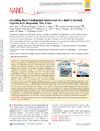Identificador persistente para citar o vincular este elemento:
https://accedacris.ulpgc.es/jspui/handle/10553/75603
| Título: | Decoding Biomineralization: Interaction of a Mad10-Derived Peptide with Magnetite Thin Films | Autores/as: | Pohl, Anna Berger, Florian Sullan, Ruby M. A. Valverde Tercedor, María Del Carmen Freindl, Kinga Spiridis, Nika Lefevre, Christopher T. Menguy, Nicolas Klumpp, Stefan Blank, Kerstin G. Faivre, Damien |
Clasificación UNESCO: | 3208 Farmacodinámica | Palabras clave: | Magnetite Magnetotactic Bacteria Magnetite-Binding Peptide Single-Molecule Force Spectroscopy Biomineralization, et al. |
Fecha de publicación: | 2019 | Publicación seriada: | Nano Letters | Resumen: | Protein-surface interactions play a pivotal role in processes as diverse as biomineralization, biofouling, and the cellular response to medical implants. In biomineralization processes, biomacromolecules control mineral deposition and architecture via complex and often unknown mechanisms. For studying these mechanisms, the formation of magnetite nanoparticles in magnetotactic bacteria has become an excellent model system. Most interestingly, nanoparticle morphologies have been discovered that defy crystallographic rules (e.g., in the species Desulfamplus magnetovallimortis strain BW-1). In certain conditions, this strain mineralizes bullet-shaped magnetite nanoparticles, which exhibit defined (111) crystal faces and are elongated along the [100] direction. We hypothesize that surface-specific protein interactions break the nanoparticle symmetry, inhibiting the growth of certain crystal faces and thereby favoring the growth of others. Screening the genome of BW-1, we identified Mad10 (Magnetosome-associated deep-branching) as a potential magnetite-binding protein. Using atomic force microscope (AFM)-based single-molecule force spectroscopy, we show that a Mad10-derived peptide, which represents the most conserved region of Mad10, binds strongly to (100)- and (111)-oriented single-crystalline magnetite thin films. The peptide-magnetite interaction is thus material- but not crystal-face-specific. It is characterized by broad rupture force distributions that do not depend on the retraction speed of the AFM cantilever. To account for these experimental findings, we introduce a three-state model that incorporates fast rebinding. The model suggests that the peptide-surface interaction is strong in the absence of load, which is a direct result of this fast rebinding process. Overall, our study sheds light on the kinetic nature of peptide-surface interactions and introduces a new magnetite-binding peptide with potential use as a functional coating for magnetite nanoparticles in biotechnological and biomedical applications. | URI: | https://accedacris.ulpgc.es/handle/10553/75603 | ISSN: | 1530-6984 | DOI: | 10.1021/acs.nanolett.9b03560 | Fuente: | Nano Letters [ISSN 1530-6984], v. 19 (11), p. 8207-8215 |
| Colección: | Artículos |
Citas de WEB OF SCIENCETM
Citations
10
actualizado el 08-jun-2025
Visitas
173
actualizado el 25-oct-2025
Descargas
254
actualizado el 25-oct-2025
Google ScholarTM
Verifica
Altmetric
Comparte
Exporta metadatos
Los elementos en ULPGC accedaCRIS están protegidos por derechos de autor con todos los derechos reservados, a menos que se indique lo contrario.
